Debbie Geographic World
Spiders
| Bats | Snakes
| Ants | Cockroaches
| Leeches | Rats
& Mice
|
Most snakes hatch from eggs
(oviparous). Racers, bullsnakes, milk snakes and green snakes
are common egg-layers. The
eggs are usually white and have an oblong, leathery-like shell.
Eggs are normally deposited
in a location that is moist and relatively warm such as sand,
sawdust piles, rotting stumps,
or
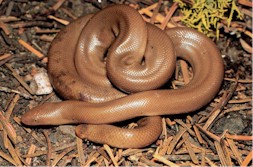 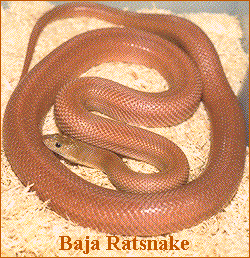
Rubber Boa (Charina bottae);
Baja ratsnake (Bogertophis rosaliae)
| under rocks. Snake eggs are
not incubated like bird eggs; the warmth of the substrate and rays of the
sun control the incubation process. Incubation may last up to 60 days before
the young are fully developed and hatch. Other snakes, such as garter snakes
and rattlesnakes, have live birth of the fully developed young (ovoviviparous).
The fertile eggs develop within the maternal body.
Food
All snakes are predators. They
must locate their prey before they seize it. Snakes will eat whatever they
can catch, master, and swallow. Their prey is located by their senses of
vision, smell, or thermosensitivity. The food they consume depends upon
the animal’s size and the environment where it lives. Rattlesnakes eat
rodents such as mice, ground squirrels, and the young of prairie dogs and
cottontail rabbits. They also eat other snakes, lizards, birds, and insects.
The average snake will consume two to three times its own weight in various
food items between the spring and fall months when the snake is away from
its winter den.
Hearing
Snakes do not have external
ears and are probably deaf to most sounds.They "hear" by sensing ground
vibrations with their belly scales and lower jaw.
Sight
A snake’s vision is mainly
used for detecting movement of prey. They have difficulty seeing motionless
prey or enemies. Objects probably appear as a blur at 40 feet, but at 10
to 15 feet, the objects appear sharper. The vision of many snakes, like
the rattlesnake, is better suited for nocturnal searching. Some species,
such as racers and garter snakes, have eyes specialized for daytime activity.
Snakes appear to stare at their prey because they have no eyelids. The
eyes of snakes are lidless, but are protected by a tough, transparent covering,
or scale, that is shed with the skin. The pupil or the black portion of
a rattlesnake’s eye is elliptical, not round as found with the nonvenomous
snakes. |
|
|

(Figure compliments of Missouri
Dept. of Conservation)
|
All
snakes are covered with scales, which are thickened areas of a thin outer
skin layer. Under this layer is another skin layer that contains pigment
cells that give a snake its distinctive color pattern. The arrangement
of color patterns, type of scales, and scale rows are used to identify
the various species.
Rattlesnakes, bullsnakes, and
garter snakes have what is called a keeled scale (Figure 3 below), which
has a ridge on the center of each scale. Other snakes, such as the racer
and milk snake, have smooth scales (Figure 2 below), with no ridges. The
skin of a snake is dry, not slimy. Molting, or skin shedding, is repeated
periodically throughout a snake’s life. Just prior to shedding, the skin
becomes dull and dry looking and the eyes become cloudy or blue-colored.
After a few days, the eyes clear and the snake "crawls" out of its old
skin, which peels backward over the body from head to tail, in one piece.
A new, larger, and brighter layer of skin has formed underneath. An older
snake may shed its skin only once or twice a year, but a younger, still-growing
snake, may shed up to four times a year.
Check the range maps (on snake
pages) to determine if the species of snake actually occurs in your area.
For each species there is a listing of key characteristics that will help
you distinguish the snake from those of similar appearance. Each snake
description includes whether the species has keeled or smooth scales.
|
|
|
Figure compliments of Joseph T.
Collins)
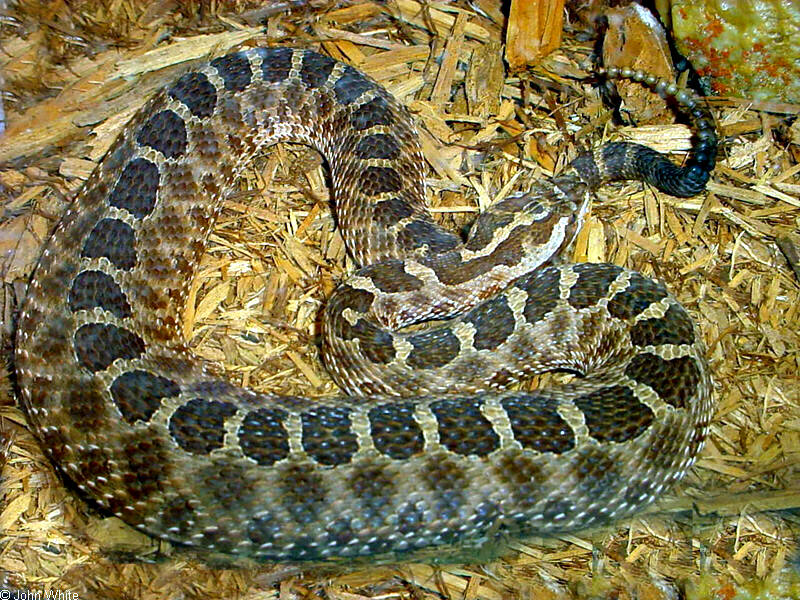

|
| Snakes are ectotherms, which
means they regulate their body temperature by taking heat from their environment
or by giving off heat. Because their body temperature is affected by environmental
temperatures and varies with surrounding conditions, snakes are inactive
during hot seasons (aestivation) and cold seasons (hibernation). Snakes
may go for several weeks without eating because of frequent periods of
inactivity.
Because snakes are cold-blooded,
they must rely on behavior to regulate their body temperature. During the
hot part of the day, snakes move to shaded areas. On cool days, they sun
themselves on rocks or in warm and open areas. Snakes often seek out paved
roads because they are attracted by the heat from the road surface.
Because snakes have a backbone,
they are classified in the same group (vertebrates) as fish, mammals, birds
and humans. The snake's skeletal system is unique. Snake bones are light
and highly movable. The lower jaws and skull are connected by a piece of
stretchy material called a ligament. This allows the snake to open its
mouth wide and move each jaw independently. Thus, a snake can swallow prey
much larger than its head.
Snakes do not have legs, ears
or eyelids. Often the sex organs of a snake protrude from the anal plate
area, and some might think these are legs.
Snakes use their forked tongues
to smell. Their tongue constantly flicks to pick up airborne particles
and odors. Once it detects these aromas, the snake inserts its tongue into
two holes on the top of its mouth (Jacobson's organ), where its brain interprets
the smells. If the snake detects food and is hungry, it will pursue the
animal.
Contrary to popular belief,
snakes are not slimy. In fact, they feel dry to the touch. The snake's
scales and skin help keep it from losing moisture from its body. Snakes
shed their skin and eye covering together.
With the warmth of spring,
snakes emerge from their winter quarters and search for food and mates.
After mating, the male and female snakes separate. Each goes its own way
to forage for food until the fall.
Some snakes lay eggs in a damp,
protected area where they will hatch in about two months. Other snakes
hatch eggs inside the body. Copperheads, rattlesnakes, cottonmouths, garter
snakes and water snakes give birth to live young. Once the young have been
hatched or born, they are able to take care of themselves. If you find
snake eggs around your home or garden, they were laid by a harmless snake.
All snakes are predators, and
many are particular about what they eat. Rat snakes eat rats, mice, voles
and bird eggs. Water snakes feed primarily on dead, diseased or injured
fish. King snakes feed on other snakes, mice, young birds and bird eggs.
Some small snakes (the rough green snake) eat insects while others (earth
snakes and worm snakes) eat earthworms, slugs and salamanders. Toads are
the favorite food of the hognose snake.
When people encounter a snake,
they often corner it. Then the snake will hiss loudly, open its mouth in
a threatening manner, coil up and strike at the individual or bluff by
advancing toward the person. These behaviors are designed to scare off
an intruder. They lead, however, to a common misconception that snakes
charge or attack people. In most cases, a snake reacts only if it feels
threatened. Usually, it crawls away if it can reach cover safely. One exception
is the male black racer, which may chase larger animals, including humans,
when it is defending its breeding territory.
Habitat
Snakes like to live in damp,
dark, cool places where food is abundant. Likely places to find snakes
around homes include
Firewood stacked directly on
the ground,
Old lumber or junk piles,
Gardens and flower beds with
heavy mulch,
Untrimmed shrubs and shrubs
growing next to a foundation,
Unmowed and unkept lawns,
abandoned lots and fields with tall vegetation,
Pond and stream banks with
abundant debris and trash,
Cluttered basements and attics
with a rodent, bird or bat problem, and
Feed storage areas in barn
haylofts where rodents abound.
Identification of poisonous
snakes
Pupil
shape
Harmless snakes have round
pupils (the black part in the center of the eye). Poisonous snakes have
egg-shaped or cat-like (elliptical) pupils. In good light, you easily can
see the pupil shape from a safe distance because snakes cannot jump, nor
can they strike, from more than one-third of their body length.
Pit
Poisonous snakes in Missouri
also have a conspicuous sensory area or pit (hence the name "pit viper")
on each side of the head. The pit looks somewhat like a nostril and helps
the snake locate warm-bodied food. It is located about midway between and
slightly below the eye and nostril Harmless snakes do not have pits.
Scale
arrangement
The underside scales of a
poisonous snake's tail go all the way across in a single row from the anal
plate (see Figure 2). The tip of the tail may have two scale rows. Nonpoisonous
snakes have two rows of scales from the vent to the end of the tail. This
characteristic also can be seen on skins that may have been shed.
Other features may help you
identify a poisonous snake at a distance
Head
shape
Usually, poisonous snakes
have a triangular (wide at the back and attached to a narrow neck) or "spade-shaped"
head. Be aware that many other harmless snakes flatten their heads when
threatened and may appear poisonous.
Distinctive sound
Usually, rattlesnakes sound
a warning rattle (a buzz or a dry, whirring sound) when approached. However,
many nonpoisonous snakes (black racers, corn snakes, rat snakes, milk snakes
and pine snakes) and several poisonous snakes (copperhead and cottonmouth)
often vibrate their tails when threatened. The sound produced by this vibration
often imitates a rattle or hissing sound when the snake is sitting in dry
grass or leaves.
You can
learn to distinguish poisonous snakes from nonpoisonous species by their
color and pattern.
Color
patterns and markings
Snakes with lengthwise-striped
markings are nonpoisonous. Most solid-colored snakes also are nonpoisonous,
except the adult western cottonmouth, which has dark crossbands that often
are indistinct. If a snake is marked in any other way, use other characteristics
for identification.
Tail
You easily can recognize young
cottonmouths and copperheads by their bright yellow or greenish yellow
tails.
Snake bites
Snake bites occur despite
precautions. Most first-aid texts do not encourage victims of snake bites
to kill the snake. The victim may wind up being bitten a second time. Whether
the snake is poisonous or harmless can be determined within a few minutes
if the victim begins to experience pain and swelling at the bite. Also,
all snake bites normally are treated with crotalid antivenom, applicable
to all poisonous species in the state, so identifying the snake is not
as important as it once may have been.
You should ask your doctor
during a regular visit for advice regarding snake bites.
If you
are bitten
Stay calm
Get medical help quickly
Beneficial aspects of snakes
Before deciding to kill a
snake in your yard or garden, consider the many benefits of snakes. Snakes
are one of nature's most efficient mouse traps; they kill and eat a variety
of rodent pests. Although snakes will not eliminate pests, they do help
keep their numbers in check. Some harmless snakes (king snakes, milk snakes
and black racers) eat other snakes, including poisonous ones.
Snake venom has been used to
develop a variety of human medicines. One type of high-blood-pressure medicine
was developed using information based on chemical secrets contained in
snake venom. Researchers are conducting studies using snake poisons in
developing treatments for blood and heart problems. Snake venom also is
being investigated for controlling some types of harmful bacteria.
Snakes in Missouri are protected
by state law. The Wildlife Code of Missouri treats snakes, lizards and
most turtles as nongame. This means there is no open season on these animals,
and it is technically illegal to kill them. Of course, realistic exceptions
exist, such as when a poisonous snake comes in close contact with humans,
which could result in someone getting bitten. You should get a collecting
permit from the Missouri Department of Conservation before attempting to
catch and keep a snake. |
|
|
|
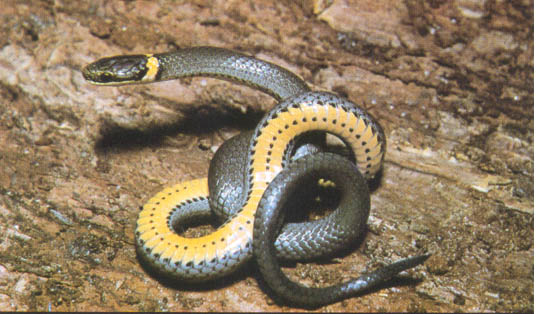
Ringneck Snake
Diadophis punctatus
Controlling
snake problems
The most effective and lasting
method for discouraging snakes is to modify the environment so they find
it unattractive.
Habitat
modification
Modify the environment by
removing the snake's shelter and its food source.
Lawns and fields kept clean
and closely mowed are less attractive to snakes than are areas of tall
grass, weeds, brush and junk. Remove other hiding places, such as old boards
lying on the ground and piles of rock and trash. Trim shrubs and bushes
so limbs are at least 12 inches from the ground.
Stack fireplace or stove wood
away from your home on a rack at least 12 inches off the ground.
Cleaning around the yard also
removes rodent habitat, eliminating a favorite food source for snakes.
Also, reduce a snake's food source by placing garbage in sealed trash cans
(not bags) away from the house. If you feed pets outside, keep all dog
food and cat food cleaned up after each feeding, and store feed in a steel
trash can, making it unavailable to rodents.
Chemical control
No fumigants or toxicants
are federally registered for snake control. The potential for development
of such snake controls is complicated by the diet, body temperature and
other biological aspects of snakes.
Currently, only one chemical
for repelling snakes is registered in Missouri. It is available under the
brand name Dr. T's Snake Away¨ and contains the active ingredients
napthelene and sulfur. However, research has shown that repellents may
not be effective under some circumstances.
|
|
|
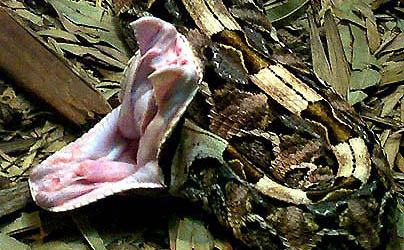 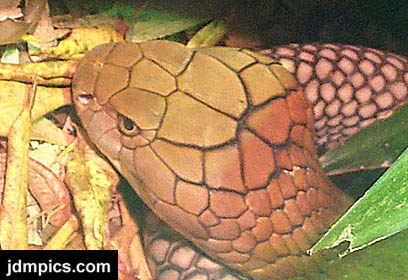
King Cobra at the Riverbanks
Zoo
Columbia, South Carolina,
USA (November 11, 2005)
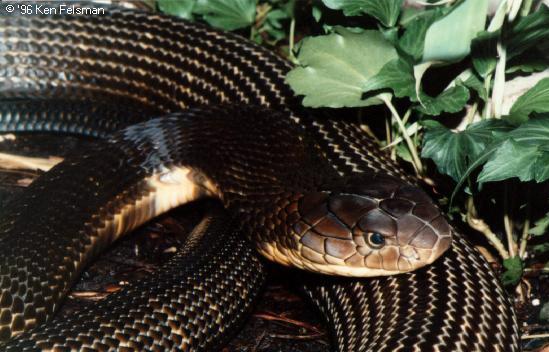
King Cobra
Exclusion
Snakes enter buildings in
search of cool, damp, dark areas or places where rodents and insects abound.
To prevent these unwanted guests from entering your home, check the foundation
for cracks and openings one-fourth inch or larger.
To seal holes or cracks, use
mortar for poured concrete, concrete block or brick foundations. Use one-eighth-inch
hardware cloth or sheet metal for wooden buildings. Use caulk to seal cracks
and openings around windows, doors, electrical pipes and wiring.
If you have an open septic
tank or sump-pump drain outside, cover the opening with one-fourth-inch
hardware cloth. Check it periodically to ensure that the wire does not
interfere with drainage.
If you have young children
and live in an area where poisonous snakes are common, you may want to
invest in a snake-proof fence . Semipermanent snake-proof fences are expensive
to construct, so fencing an entire yard is not practical. However, you
can enclose a small area where young children play.
To construct a semipermanent
snake-proof fence, use one-fourth-inch hardware cloth at least 36 inches
wide. Bury the lower 4 inches of the fence underground. The fence should
slant outward at a 30-degree angle. Place supporting stakes inside the
fence (see Figure 9 detail). You can make the fence sturdier by attaching
wires from the fence to the stakes. If you use a gate, it must fit tightly
and should open to the inside because of the outward slope of the fence.
A more temporary, less expensive
design uses a fine-mesh net, buried two inches to three inches in the ground,
with metal or wooden support stakes slanted outward at a 30-degree angle
for support.
Keep grass and weeds around
the fence mowed close to the ground to prevent snakes from using them to
crawl over the fence.
Removal
from inside buildings
Occasionally, homeowners find
a snake inside the home, usually in a basement or crawl space. Snakes are
attracted to these areas by the warmth on cold days and the shade on hot
days. They may enter through a hole around the foundation or an open or
loose door or basement window. If this occurs, you need to get the snakes
out, then seal the holes.
You increase your chances of
capturing a snake in the house by placing in areas where snakes have been
seen some rumpled, damp cloths covered by dry cloths. Snakes are attracted
to these areas. You then can remove the whole works, snake and cloths,
or capture the snake individually. A good way to remove a snake is to sweep
it with a broom into a large bucket.
Another effective way to capture
snakes is to use a glueboard. You can buy these in a variety of places,
such as agriculture-supply or hardware stores. Most small snakes can be
captured using a single glueboard placed against a wall. Keep the board
away from pipes or other objects a snake could use for leverage to escape.
A more elaborate arrangement
is necessary to capture larger snakes This type of glue trap can
be made at home with purchased glueboards. It is constructed of one-quarter-inch
plywood cut into 16-inch by 24-inch sections. Drill a three-quarter-inch
hole in one corner to allow removal of the board by using a hook on the
end of a long stick. Fasten two to four glueboards (or use bulk glue) along
one side of the plywood board. This type of trap, when placed against a
wall, is capable of capturing snakes up to 5 feet or 6 feet long.
Use glueboards only indoors
or under structures where children, pets or other wildlife cannot reach
them. The glue is quite messy and hard to remove. Use common cooking oil
or vegetable oil to remove animals from the glue. Be sure to seal any holes
or entrances so the snakes do not return. Another option is to use the
newly developed snake trap called Snake Guardª. It should be used
like a glueboard.
Remember, snakes are an important
part of our natural world. The best approach in managing snake problems,
where possible, is to leave the animal alone.
|
|
|
Several field guides also are
available, including:

Northern Copperhead
(Agkistrodon contortrix mokasen)

| Snake
Venom: A poisonous snake has two fangs, which are grooved or hollow
teeth, situated at the front of the upper jaw. Each fang is connected by
a duct to a poison gland behind the eye on the corresponding side. These
two poison glands are modified salivary glands, the secretion of which
is called venom. When the snake bites, the venom is excreted into the fang
wounds. Venom probably helps the snake is killing its prey and facilitates
digestion.
Fresh venom is clear viscid
liquid and yellowish in color. The extracted venom, when dried, forms yellow
crystals which retain toxicity and solubility in water for a long time,
and is used for immunizing horses in the production of antivenine sera
and also for research work. |
|
|
![Tree boa [Sanzinia madagascariensis] (Andasibe)](tree_boa_0106.jpg)
Tree boa [Sanzinia madagascariensis]
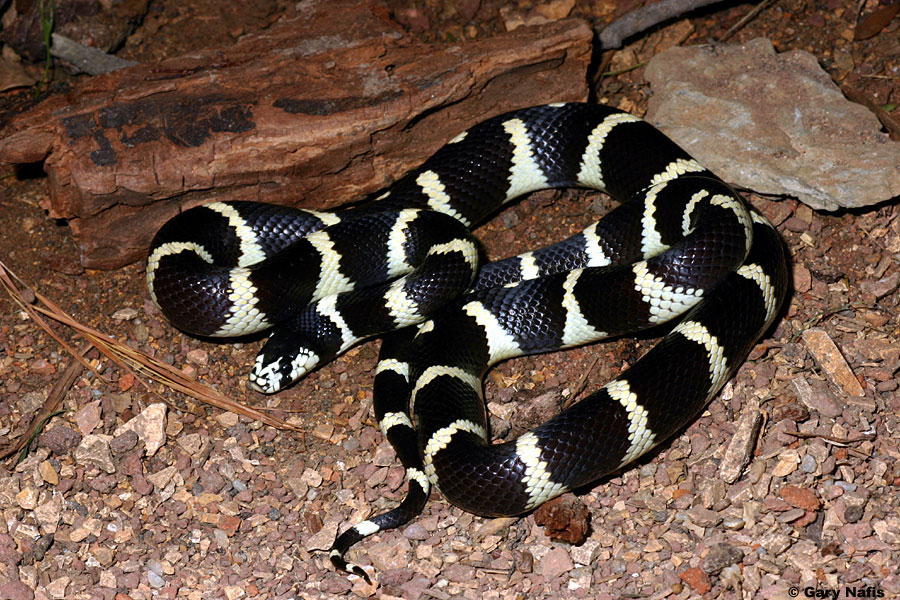
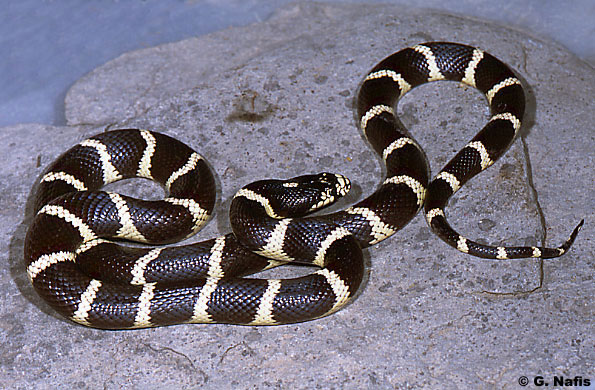
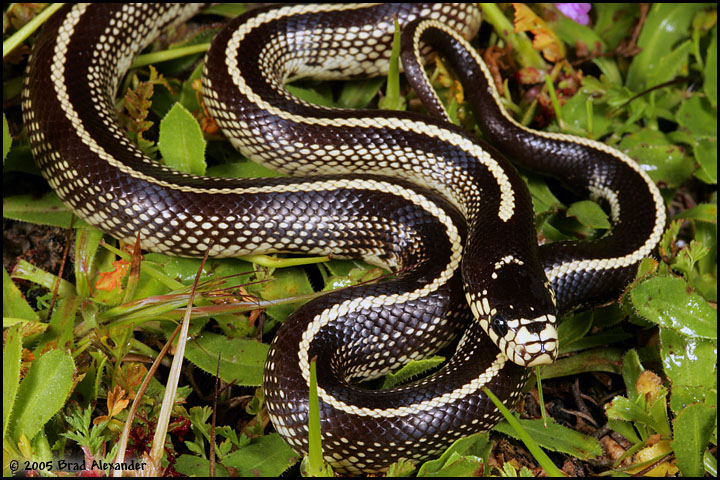
California Kingsnake
|
|
|











![Tree boa [Sanzinia madagascariensis] (Andasibe)](tree_boa_0106.jpg)


